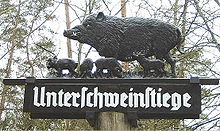Acorn mast

The acorn , in German-speaking area also spreads corner Rich called, was one until the 19th century widespread agricultural practice in Central Europe. Domestic pigs were driven into the woods so that they could eat their fill of acorns , beechnuts and chestnuts . The word mast originally referred to the tree fruits used as fodder. It was later restricted to acorns and beechnuts as pig feed. Today the word fattening is generally used for "fat" animals. In addition, the seed production of oaks and beeches was referred to as Eckerich, Ecker, Äcker or Acker. The field was derived from this from an agricultural point of view.
history

Already in the Carolingian Franconian Empire , the value of a forest was assessed according to how much it could be used for pasture farming. The evaluation of the forest according to its grazing capacity continued into the early 19th century. Forestry textbooks calculated the value of an oak forest not according to the presumed timber yield , but according to the capitalized acorn revenue, the Dehme .
The fattening law was already a medieval law that stipulated who was allowed to drive pigs for fattening in a certain area of forest. Separately from other rights, it was alienable. In countries such as Switzerland , where the forest was owned by municipalities, it was precisely defined who was allowed to drive how many pigs into the forest. This often also depended on the fruit set in the oak. In years of full fattening all pigs could be grazed in the forest, in years with only poor fruit set it was only selected animals. In the English linguistic area, the term includes Commons (German commons ) one of the crown or community belonging forest, which stood for Acorn or maple mast available.
Effects
The acorn fattening also contributed to the fact that the domestic pig resembled the wild boar for a long time , as the sows were very often covered by boars . In depictions up to the end of the 18th century it is shown as a long-legged animal with an arched back and obviously very little fat. The first modern domestic pig breeds did not develop until the 19th century. Most domestic pig breeds have their origins in the 20th century.
Pig grazing had a major impact on the appearance of the forest. They were more or less loose groves with mighty crowns, as are typical for free-standing oaks. A natural forest regeneration could not arise through the pig drive. Oaks that would have been displaced by the common beech in a naturally grown forest were particularly encouraged by this management practice (which creates so-called hat forests ).
Fattening exclusively in beech trees resulted in a soft pork fat with a somewhat tranquil taste, whereas in oak forests it was a rather coarse fat. The so-called Schmalzweide , a willow in roughly equal parts with beech and oak, produced the best ham in the opinion of the farmers.
Acorn fattening is still known today in southern Spain and Portugal among the Iberian pigs , which are often kept semi-wild and fattened in cork oak and holm oak groves ( Dehesas / Montados ) , and which produce the famous Iberian acorn ham ( Jamón Ibérico de Bellota ). Further examples of existing forms of forest pasture in Europe with pigs are the pasture of pigs in Central Italy and the grazing of the saveau with woolly pigs ( Mangalitza , Turopolje ) in Croatia .
mythology
In the Irish legend De chophur in da muccida ("From the [metamorphosis?] Of the two swineherd"), a dispute over the best acorn-fed areas leads to a magic contest between the swineherd of Connacht and Munster - this is a Remscéla ("prehistory") ) of the Ulster main legend Táin Bó Cuailnge ("The cattle robbery of Cooley ").
literature
- Karl Hasel , Ekkehard Schwartz : Forest history. A floor plan for study and practice . 2nd updated edition. Kessel, Remagen 2002, ISBN 3-935638-26-4 .
- Hans-Hinrich Huss: Pig fattening under oaks: The best hams grow under oaks . In: Bavarian State Institute for Forests and Forestry (ed.): Forest research current . Volume 13, No. 55, issue 4-2006, Freising 2006, pp. 20-22, overview (PDF file).
- Anja Kastner: Comparative studies on the influence of acorn fattening and ripening on the aroma of air-dried raw ham and raw sausages using gas chromatography / mass spectrometry . Dissertation. University of Veterinary Medicine Hannover 2008, PDF file .
- Christian Küchli: The best hams grow on the oaks - ten intimate tree portraits . AT Verlag, Aarau 2000, ISBN 3-85502-714-5 .
- James J. Parsons: Acorn-fed pig farming in the oak forests of southwestern Spain . Translated into German by Armin and Roswitha Hüttermann. In: Hans-Wilhelm Windhorst (ed.): Contributions to the geography of forest and forestry . Scientific book society. Darmstadt 1978, pp. 147-175, ISBN 3-534-07396-7 .
Web links
- The acorn fattening project in the Basdorfer Hutewald with Düppel pigs, Swabian-Hall pigs and colorful Bentheim pigs
- EICHELSCHWEIN® GmbH
Individual evidence
- ↑ Patrick Hemminger: The delicious freedom of the acorn pigs . In: sueddeutsche.de . 2018, ISSN 0174-4917 ( sueddeutsche.de [accessed December 20, 2018]).
